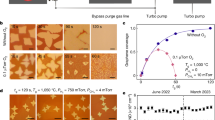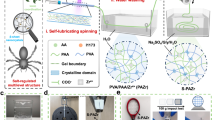Abstract
Graphene oxide (GO) and reduced GO possess robust mechanical, electrical and chemical properties. Their nanocomposites have been extensively explored for applications in diverse fields. However, due to the high flexibility and weak interlayer interactions of GO nanosheets, the flexural mechanical properties of GO-based composites, especially in bulk materials, are largely constrained, which hinders their performance in practical applications. Here, inspired by the amorphous/crystalline feature of the heterophase within nacreous platelets, we present a centimetre-sized, GO-based bulk material consisting of building blocks of GO and amorphous/crystalline leaf-like MnO2 hexagon nanosheets adhered together with polymer-based crosslinkers. These building blocks are stacked and hot-pressed with further crosslinking between the layers to form a GO/MnO2-based layered (GML) bulk material. The resultant GML bulk material exhibits a flexural strength of 231.2 MPa. Moreover, the material exhibits sufficient fracture toughness and strong impact resistance while being light in weight. Experimental and numerical analyses indicate that the ordered heterophase structure and synergetic crosslinking interactions across multiscale interfaces lead to the superior mechanical properties of the material. These results are expected to provide insights into the design of structural materials and potential applications of high-performance GO-based bulk materials in aerospace, biomedicine and electronics.
This is a preview of subscription content, access via your institution
Access options
Access Nature and 54 other Nature Portfolio journals
Get Nature+, our best-value online-access subscription
$29.99 / 30 days
cancel any time
Subscribe to this journal
Receive 12 print issues and online access
$259.00 per year
only $21.58 per issue
Buy this article
- Purchase on Springer Link
- Instant access to full article PDF
Prices may be subject to local taxes which are calculated during checkout





Similar content being viewed by others
Data availability
All data supporting the findings of this study are available within the paper and its Supplementary Information. Other supporting data are available from the corresponding authors upon request.
Code availability
The codes or algorithms used to analyse the data reported in this study are available from the corresponding authors upon request.
References
Dikin, D. A. et al. Preparation and characterization of graphene oxide paper. Nature 448, 457–460 (2007).
Kotov, N. A., Dékány, I. & Fendler, J. H. Ultrathin graphite oxide-polyelectrolyte composites prepared by self-assembly: transition between conductive and non-conductive states. Adv. Mater. 8, 637–641 (1996).
Joshi, R. K. et al. Precise and ultrafast molecular sieving through graphene oxide membranes. Science 343, 752–754 (2014).
Yeh, C.-N. et al. Binder-free graphene oxide doughs. Nat. Commun. 10, 422 (2019).
Xin, G. et al. Highly thermally conductive and mechanically strong graphene fibers. Science 349, 1083–1087 (2015).
Chang, D. et al. Reversible fusion and fission of graphene oxide-based fibers. Science 372, 614–617 (2021).
Kovtyukhova, N. I. et al. Layer-by-layer assembly of ultrathin composite films from micron-sized graphite oxide sheets and polycations. Chem. Mater. 11, 771–778 (1999).
Zhao, C. et al. Layered nanocomposites by shear-flow-induced alignment of nanosheets. Nature 580, 210–215 (2020).
An, Z. et al. Bio-inspired borate cross-linking in ultra-stiff graphene oxide thin films. Adv. Mater. 23, 3842–3846 (2011).
Wang, C. et al. Freeze-casting produces a graphene oxide aerogel with a radial and centrosymmetric structure. ACS Nano 12, 5816–5825 (2018).
Zhu, C. et al. Highly compressible 3D periodic graphene aerogel microlattices. Nat. Commun. 6, 6926 (2015).
Wang, B. et al. Folding large graphene-on-polymer films yields laminated composites with enhanced mechanical performance. Adv. Mater. 30, 1707449 (2018).
Jia, H. et al. Bioinspired nacre-like GO-based bulk with easy scale-up process and outstanding mechanical properties. Compos. Part A Appl. Sci. Manuf. 132, 105829 (2020).
Chen, S. M. et al. Superior biomimetic nacreous bulk nanocomposites by a multiscale soft-rigid dual-network interfacial design strategy. Matter 1, 412–427 (2019).
Meyers, M. A., McKittrick, J. & Chen, P. Y. Structural biological materials: critical mechanics–materials connections. Science 339, 773–779 (2013).
Chen, K. et al. Amorphous alumina nanosheets/polylactic acid artificial nacre. Matter 1, 1385–1398 (2019).
Nassif, N. et al. Amorphous layer around aragonite platelets in nacre. Proc. Natl Acad. Sci. USA 102, 12653–12655 (2005).
Wegst, U. G. K., Bai, H., Saiz, E., Tomsia, A. P. & Ritchie, R. O. Bioinspired structural materials. Nat. Mater. 14, 23–36 (2015).
Das, P. et al. Nacre-mimetics with synthetic nanoclays up to ultrahigh aspect ratios. Nat. Commun. 6, 5967 (2015).
Yin, Z., Hannard, F. & Barthelat, F. Impact-resistant nacre-like transparent materials. Science 364, 1260–1263 (2019).
Bouville, F. et al. Strong, tough and stiff bioinspired ceramics from brittle constituents. Nat. Mater. 13, 508–514 (2014).
Mao, L. B. et al. Synthetic nacre by predesigned matrix-directed mineralization. Science 354, 107–110 (2016).
Cantaert, B. et al. Use of amorphous calcium carbonate for the design of new materials. ChemPlusChem 82, 107–120 (2017).
Gao, H. L. et al. Mass production of bulk artificial nacre with excellent mechanical properties. Nat. Commun. 8, 287 (2017).
Jia, B. et al. Construction of MnO2 artificial leaf with atomic thickness as highly stable battery anodes. Adv. Mater. 32, 1906582 (2020).
O’Neill, M. A., Eberhard, S., Albersheim, P. & Darvill, A. G. Requirement of borate cross-linking of cell wall rhamnogalacturonan II for Arabidopsis growth. Science 294, 846–849 (2001).
Luo, J. et al. Graphene oxide nanocolloids. J. Am. Chem. Soc. 132, 17667–17669 (2010).
Park, S. et al. Graphene oxide papers modified by divalent ions-enhancing mechanical properties via chemical cross-linking. ACS Nano 2, 572–578 (2008).
Wan, S., Li, Y., Mu, J., Aliev, A. E. & Baughman, R. H. Sequentially bridged graphene sheets with high strength, toughness, and electrical conductivity. Proc. Natl Acad. Sci. USA 115, 5359–5364 (2018).
Claramunt, S. et al. The importance of interbands on the interpretation of the Raman spectrum of graphene oxide. J. Phys. Chem. C 119, 10123–10129 (2015).
Dong, X., Zhao, Q., Xiao, L., Lu, Q. & Kaplan, D. L. Amorphous silk nanofiber solutions for fabricating silk-based functional materials. Biomacromolecules 17, 3000–3006 (2006).
Amini, S., Tadayon, M., Idapalapati, S. & Miserez, A. The role of quasi-plasticity in the extreme contact damage tolerance of the stomatopod dactyl club. Nat. Mater. 14, 943–950 (2015).
Li, L. & Ortiz, C. Pervasive nanoscale deformation twinning as a catalyst for efficient energy dissipation in a bioceramic armour. Nat. Mater. 13, 501–507 (2014).
Heinz, H., Lin, T.-J., Mishra, R. K. & Emami, F. S. Thermodynamically consistent force fields for the assembly of inorganic, organic, and biological nanostructures: the INTERFACE force field. Langmuir 29, 1754–1765 (2013).
Yeom, B. et al. Abiotic tooth enamel. Nature 543, 95–98 (2017).
Koester, K. J. & Ritchie, R. O. The true toughness of human cortical bone measured with realistically short cracks. Nat. Mater. 7, 672–677 (2008).
Kolednik, O., Predan, J., Fischer, F. D. & Fratzl, P. Bioinspired design criteria for damage-resistant materials with periodically varying microstructure. Adv. Funct. Mater. 21, 3634–3641 (2011).
Morits, M. et al. Toughness and fracture properties in nacre-mimetic clay/polymer nanocomposites. Adv. Funct. Mater. 27, 1605378 (2017).
Wang, L. et al. Microstructure and mechanical properties of nacre-like alumina toughened by graphene oxide. Ceram. Int. 45, 8081–8086 (2019).
Grossman, M. et al. Hierarchical toughening of nacre-like composites. Adv. Funct. Mater. 29, 1806800 (2019).
Wegst, U. G. K. & Ashby, M. F. The mechanical efficiency of natural materials. Philos. Mag. 84, 2167–2181 (2004).
Acknowledgements
This research was supported by the National Natural Science Foundation of China (nos. 51532001, 21905011 and 51772011). We thank J. Huang, L. Ding and X. Liu for performing various tasks in this research. SAXS measurements were supported by Y. Liu from the Testing and Evaluation Center for High-performance Fibres at BUAA.
Author information
Authors and Affiliations
Contributions
L.G., L.D., X.D., K.C. and X.T. conceived the project and designed experiments. K.C., X.T. and B.J. carried out the design and fabrication of the lamellar composites. X.T., K.C. and B.J. characterized all samples. X.T., J.H. and K.C. performed mechanical testing. K.C., X.T. and J.H. performed in situ tensile tests. L.D. and C.C. carried out FE simulation. X.T. and C.C. compiled the videos. L.G., K.C., X.T., L.D., C.C., X.D., Y.W., B.J., T.-H.X., Y.W. and K.G. drafted the manuscript. All authors discussed the results and commented on the manuscript.
Corresponding authors
Ethics declarations
Competing interests
The authors declare no competing interests.
Peer review
Peer review information
Nature Materials thanks Lars Berglund and the other, anonymous, reviewer(s) for their contribution to the peer review of this work.
Additional information
Publisher’s note Springer Nature remains neutral with regard to jurisdictional claims in published maps and institutional affiliations.
Supplementary information
Supplementary Information
Supplementary materials, preparation and characterization methods, Figs. 1–31, Discussion and Tables 1–7.
Supplementary Video 1
Evolution process of the Von Mises stress nephogram of the nanoscale heterophase reinforcing structure under uniaxial tension mode.
Supplementary Video 2
Evolution process of the Von Mises stress nephogram of the nanoscale heterophase reinforcing structure under three-point bending mode.
Supplementary Video 3
Evolution process of the Von Mises stress nephogram of the lamellar composite structure model under three-point bending mode.
Rights and permissions
About this article
Cite this article
Chen, K., Tang, X., Jia, B. et al. Graphene oxide bulk material reinforced by heterophase platelets with multiscale interface crosslinking. Nat. Mater. 21, 1121–1129 (2022). https://doi.org/10.1038/s41563-022-01292-4
Received:
Accepted:
Published:
Issue Date:
DOI: https://doi.org/10.1038/s41563-022-01292-4
This article is cited by
-
Near-room-temperature water-mediated densification of bulk van der Waals materials from their nanosheets
Nature Materials (2024)
-
Effect of heat treatment on the interface and property enhancement of reduced graphene oxide/2024Al matrix composites
Journal of Materials Science (2024)
-
Anisotropic Mechanical Response of Nacre to Heat Treatment Under Indentation: Effect of Structural Orientation
Journal of Bionic Engineering (2024)
-
Engineered interfaces for heterostructured intermetallic nanomaterials
Nature Synthesis (2023)
-
Thin lamellar films with enhanced mechanical properties for durable radiative cooling
Nature Communications (2023)



